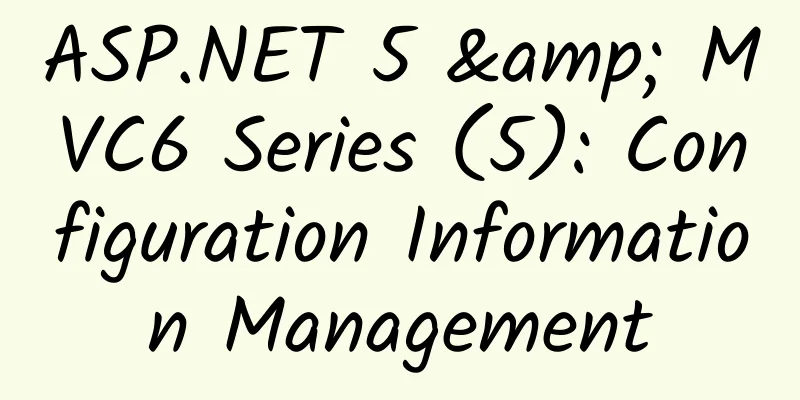ASP.NET 5 & MVC6 Series (5): Configuration Information Management

|
In the previous chapter, we know that the new version of the MVC program abandoned the original web.config file mechanism and replaced it with config.json. Today we will take a deep look at the relevant contents of the configuration file. Basic Usage The new version of the configuration information mechanism has been rewritten in the Microsoft.Framework.ConfigurationModel namespace. After the rewrite, it not only supports XML format, but also supports json, ini, environment variables, etc. In the constructor of the Startup class in the template sample program, there are the following statements:
The purpose of this statement is to add the config.json file and environment variable information to the configuration information container for reading. When reading, you can use the collection index or Get method to read, as shown below:
To read multi-level keys, you need to separate the multiple level names with colons, as shown below:
From the above code snippets, we can see that this configuration example is not a global instance, so if we want to read this information elsewhere, we need to save the instance in a global static variable. Architecture Design The new configuration information processing mechanism, after being rewritten, is more lightweight and cross-platform. It can obtain configuration information from multiple data sources without being restricted to .config files, and can even set different configuration information for different environments (development, testing, production). The important entities of the entire configuration mechanism are shown in the figure below: Let's talk about the specific functions of these classes one by one: 1.IConfiguration - instance interface of configuration information. The indexer, Get, TryGet, Set and other methods like Reload on this interface are used together to obtain key/value based configuration information. 2.IConfigurationSource - This interface unifies the interface methods used by various configuration sources, such as TryGet, Set, and the most important load method for reading configuration information, so as to load the information into the configuration subsystem. 3.IConfigurationSourceContainer - a container for all configuration source information, which enables configuration information from various configuration sources to be loaded on a single Configuration instance. This interface has only one Add method for adding configuration source information based on IConfigurationSource. 4.Configuration - This class implements the IConfiguration interface and the IConfigurationSourceContainer interface and does not save all types of configuration information based on key/value. 5.ConfigurationExtensions - Extension methods used to quickly load configuration information, such as AddCommandLine, AddIniFile, etc. In the Microsoft.Framework.ConfigurationModel namespace, there are currently 6 different types of configuration source types available, as follows: 1.MemoryConfigurationSource - This configuration source currently has no built-in add/load extension methods (such as AddMemoryConfiguration), but you can load key/value type collections for this purpose (such as IEnumerable 2.IniFileConfigurationSource - This configuration source can load INI file configuration information based on key/value format into the configuration system. 3. CommandLineConfigurationSource - loads the command line parameter information when the program is started into the configuration system. 4. EnvironmentVariablesConfigurationSource - Loads the operating system's environment variable information into the configuration system. In Azure Website, environment variables can be set through the web interface, which makes management quite convenient. 5.JsonConfigurationSource - loads the information of the json file into the configuration system. 6.XmlconfigurationSource - loads information from xml files into the configuration system. Detailed usage First, since the configuration system is multi-instance, you must declare an instance before each use. The code is as follows:
Add IniFileConfigurationSource The configuration information of the IniFileConfigurationSource type can be loaded through the extension method. The code is as follows:
The format template of the ini file is as follows:
Here [ini-sec] is a custom configuration section name. Multiple key/value items can be configured under each configuration section. The value selection method is the same as in the basic example. The levels (in this case, between the configuration section and the key) should be separated by colons. The example is as follows:
Add CommandLineConfigurationSource The parameters passed in when the program uses the k run command can be read through the configuration source, or you can add them manually through the AddCommandLine extension method, as shown below:
Each string in the above example must be in key/value format, and special symbols such as $, /, etc. can be used. For these key values, you can also use the CommandLineConfigurationSource class with a switchMappings parameter constructor to map certain keys. The data type and example of the switchMappings parameter are as follows:
Since there is currently no extension method for the CommandLineConfigurationSource class, we still need to instantiate the class ourselves and add it to the configuration container. The code is as follows:
After executing the above code, when getting the configuration value, the values of the following two keys are the same:
When mapping, the new mapping key string cannot contain the "/" character, otherwise an exception will be reported. The same key cannot be passed twice, otherwise an exception will be reported. When loading configuration information, if there is a duplicate key, the value of the latter key will overwrite the value of the previous key. When loading CommandLine configuration information, if a key string is prefixed with -, then switchMapping must be used to map a new key to the old key, otherwise an error will occur. Add EnvironmentVariablesConfigurationSource IronmentVariablesConfigurationSource can add operating system environment variables to the configuration system. You can also customize these environment variables. For example, when developing and debugging in VS, you can add some key/value in the following interface: The value is as follows:
In addition, the configuration source also supports Azure environment variables and connection strings, so you can also set MSSQL, MYSQL, and custom connection strings in the Azure interface, but these connection strings need to start with the following strings:
For example, the key/value pairs for defining a development environment are as follows:
After loading the information through AddEnvirnmentVariables(), we can access this information in the following way:
That is to say, in Azure, the environment variable key will be converted into the format of Data: custom identifier: ConnectionString. If your key is not a custom key (starting with CUSTOMCONNSTR_), you can get the provider name of the connection string as follows:
In addition, a prefix filtering method is provided to load some information, such as:
In this way, when getting information again, the Data: in the key value can be omitted, as shown in the following example:
Add JsonConfigurationSource At the beginning of the article, we saw the loading of the json configuration file. To load the file, you only need to use the .AddJsonFile("test.json") extension method, but don't forget to reference the Microsoft.Framework.ConfigurationModel.Json assembly in the dependencies of project.json first. For example, if your config.json file contains the following:
{
"Data": {
"DefaultConnection": {
"ConnectionString": "Server=(localdb)\\mssqllocaldb;Database=aspnet5-WebApplication1-64357659-de50-4b1e-b005-30310e7ee1ef;Trusted_Connection=True;MultipleActiveResultSets=true"
}
},
"EntityFramework": {
"ApplicationDbContext": {
"ConnectionString": "Data:DefaultConnection:ConnectionString"
}
}
}
Then you can access the connection string as follows:
Adding XmlConfigurationSource The XmlconfigurationSource configuration source is similar to the JsonConfigurationSource configuration source. First, reference the Microsoft.Framework.ConfigurationModel.Xml assembly, and then call .AddXmlFile("test.xml"). If the content of your configuration file test.xml is as follows:
The acquisition form is slightly different (the root node will be ignored):
However, please note that common keys cannot be declared repeatedly, otherwise errors will occur when reading the following files.
Sensitive information configuration (new feature in RC version) After the release of the RC version, Microsoft has added a new sensitive information configuration implementation, the assembly is Microsoft.Framework.ConfigurationModel.UserSecrets. Through the management of this assembly, we can put sensitive configuration information in the secrets.json file in a special directory of the computer. The directory definition rules are as follows: Windows: %APPDATA%\microsoft\UserSecrets\\secrets.json Linux: ~/.microsoft/usersecrets/\secrets.json Mac: ~/.microsoft/usersecrets/\secrets.json Let's take an example. First, right-click the solution and select Manage User Secret. VS will automatically create an applicationId for the program and save it in the project.json file. The example is as follows:
Then the %APPDATA%\Microsoft\UserSecrets\aspnet5-WebDemo01-20150430014447\secrets.json file will be automatically opened. We enter a sample configuration:
Then, we referenced the above assembly in the project.json file, and registered it in a unified way through the configuration file. The code is as follows:
Then you can call it like a normal calling method, as shown below:
In this way, we can keep the configuration information of the production environment in a private location. Custom configuration source Through the above examples and looking at its architectural design mechanism, we can find that we can actually customize our own configuration source. For example, if I want to read the corresponding configuration information from the database, we only need to define a DBConfigurationSource and inherit from ConfigurationSource to implement the corresponding Load overload.
After implementing the above class, create an extension method for yourself to add DB configuration information. The code is as follows
You can add the DB configuration source through .AddDBConfiguration(). Note that the DB configuration source needs to use the database connection string. This needs attention (you can first obtain the connection string from the json configuration file and then add the configuration source). Configuration information traversal In the default configuration source implementation, all classes inherit from ConfigurationSource and store information data in the Data property. Therefore, if you want to traverse this data, you need to convert it to the ConfigurationSource type before you can use it. The sample code is as follows:
Configuration information is directly converted into entity classes There is also an extension method on the IServiceCollection interface.Configure public static IServiceCollection Configure For example, if we define the following entity:
Then, after loading the configuration information in the Startup constructor, we can assign the information to the AppSettings instance. The code is as follows:
When using, use the GetRequiredService method of ApplicationServices, as shown below:
Note: In the configuration information, all keys are case-insensitive, that is, key and KEY are the same. If multiple configuration sources have duplicate keys, the value corresponding to the key in the configuration source added later will prevail. GetSubKeys and GetSubKey under IConfiguration can get a list of all keys at a certain level (or starting with a certain level). Since Configuration is multi-instance, according to the code in the example, after the instance is initialized in Startup, other classes cannot access it. Therefore, if you want to access it globally, you should save it to a static variable after initialization. Reference 1: https://github.com/aspnet/Configuration Reference 2: http://blog.jsinh.in/asp-net-5-configuration-microsoft-framework-configurationmodel/#.VSdjUpOxxzw |
<<: Interpreting ASP.NET 5 & MVC6 Series (4): Core Technology and Environment Configuration
>>: Interpreting ASP.NET 5 & MVC6 Series (8): Session and Caching
Recommend
Can eating ginkgo nuts cure diabetes? Can soaking ginkgo leaves in water lower blood pressure and blood lipids? Improper consumption may...
gossip Ginkgo is a perennial woody plant of the G...
I created more than 10,000 titles a year. I summarized 9 rules for titles that will make users remember them.
I have been engaged in new media operations for m...
How can CPC and OCPC grab market share?
Friends who work in search advertising know that ...
Soaring into the sky! 58 years ago today, my country's J-7 fighter jet successfully completed its first test flight
On January 17, 1966, the J-7 fighter jet independ...
Let's talk seriously about programmers' self-cultivation
Today, when I was browsing the Blog Park, I saw a...
What is the principle of machine flash ASO? Understand how to do ASO on a machine in one article!
1. What is ASO ? It mainly uses machines and a se...
5 ways to master social media operations!
It is easy to build a good community, but it is n...
How to become an excellent front-end engineer
[[145462]] Philip Walton, a front-end engineer fr...
Revealing the three major pitfalls of hot marketing, new media operators, don’t you read this?
Hot topics are what brand public relations profes...
Can short video operations be both eye-catching and easy to monetize?
Wearing traditional ethnic costumes, seven native...
Hotspot drainage technology "Hotspot Traffic Code" increased 8,000 fans a day, and earned 5 figures a month.
Training course video content introduction: All k...
Four important links in content operation, you need to know
Content operation is a painful and joyful thing. ...
Will humans be replaced by artificial intelligence? Machines cannot do this
Copyrighted images from the gallery, unauthorized...
A brief discussion on the principle of WeChat QR code scanning login
Preface Hello everyone, I am programmer Amu! When...
New quantum charging technology: Fully charging an electric car in as fast as 9 seconds?
With the popularity of electric vehicles, more an...









